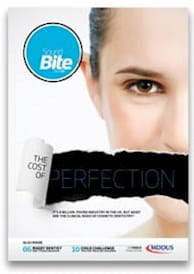BACKGROUND: Paul is 54 and works as a manager with a major hotel chain. He attends a dental clinic wanting to improve the appearance of his smile and consults with one of the dental partners – Mr K. On examination the dentist notes that Paul’s teeth are discoloured and somewhat malpositioned with gaps.
Mr K discusses treatment options with Paul including tooth whitening of the upper and lower teeth, or whitening of the lower teeth with provision of crowns and veneers in the upper teeth. Paul is keen to have both his upper and lower teeth veneered in order to have a uniform smile.
Five days later Paul attends the clinic for an extended examination. Preoperative photographs and radiographs are taken and study models made. Mr K notes no particular abnormalities in the dentition. A consent form is signed and a treatment plan agreed for the provision of veneers at UR4, UR3, UR1, UL1, UL3, UL4 and LR4 to 1 and LL1 to 4, along with crowns at UR2 and UL2.
The patient later attends the clinic to view the diagnostic wax up and agrees some further revision to the treatment plan. Five days later he re-attends and veneer and crown preparation is carried out under local anaesthetic.
Four weeks after the initial consultation the temporary restorations are removed and the veneers and crowns are fitted as per the treatment plan. A few days later Paul attends the clinic complaining of roughness and Mr K carries out some occlusal/incisal adjustment.
Three weeks later Paul phones the clinic for an emergency appointment. The veneer at UL4 has de-bonded. Mr K re-cements the veneer and again adjusts occlusion to “ease pressure on the tooth”. Two days later Paul is back at the clinic with UL4 having de-bonded again. Mr K re-cements the veneer and discusses the possibility that Paul may be grinding his teeth at night. The dentist agrees to make a splint for the patient. Two days later Paul returns to clinic now with both UL4 and UR1 having de-bonded. They again discuss teeth grinding and a lower soft splint is provided. Two days later LR3 de-bonds and must be re-cemented.
Paul attends a different dental clinic concerned now with the quality of Mr K’s restorations. The examining dentist finds cracks in UR3 and LR4 and composite fillings are placed. Later that week LR4 de-bonds and is re-cemented by the new dentist.
ANALYSIS/OUTCOME: The dental clinic receives a letter of claim from solicitors acting on behalf of Paul alleging negligence and breach of contract against Mr K. It is claimed that the dentist failed to obtain valid informed consent in the provision of veneers in that he neglected to advise the patient of the elevated risk of treatment failure due to his bruxism or teeth-clenching habit.
It is also claimed that Mr K failed to use reasonable care and skill in the assessment, diagnosis and treatment planning of the restorations carried out. More specifically the dentist failed to identify or note significant incisal and buccal edge tooth surface loss due to the patient’s bruxism. It is alleged that had Paul known of the elevated risks due to his bruxism he would not have gone ahead with the proposed treatment.
Mr K contacts MDDUS and an expert report is commissioned from a consultant in restorative dentistry. The expert is provided with the patient records including all available radiographs, photographs and study models.
Examining the pre-treatment study models the expert notes attritional wear along the incisal edges of the lower incisor teeth “more than one would expect as being normal for a patient of this age”. Evidence of wear is also obvious in the radiographs. He judges that this should have warranted further investigation of the possibility of bruxism. This observation is particularly relevant as in his view the failure of the veneers was, “on balance, related to the claimant’s bruxism habit.” A more appropriate treatment option in the opinion of the expert would have been the provision of a mouth guard before considering veneers or even better full coverage crowns.
MDDUS advises that given the expert view the best option is to settle the claim for a modest sum based on the costs for remedial treatment and ongoing care.
KEY POINTS
- Discuss with the patient all major risks and contraindications for treatment.
- Do not assume patients are necessarily aware of habits or behaviours that compromise treatment success.
- Establish and follow thorough protocols in treatment planning.
This page was correct at the time of publication. Any guidance is intended as general guidance for members only. If you are a member and need specific advice relating to your own circumstances, please contact one of our advisers.
Read more from this issue of Insight Primary

Save this article
Save this article to a list of favourite articles which members can access in their account.
Save to library